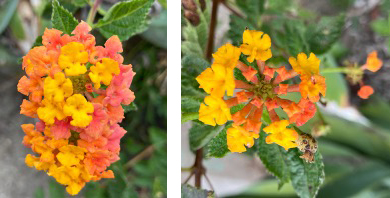
Multicolor flowers–a pollinator training strategy
Director Lew Feldman
On a recent walk through the Garden I observed the multicolored flowers of marmalade bush (Streptosolen jamesonii), shown above in the South American area. This plant is fascinating in that the flowers change color after they have been pollinated. We now know that plants evolved multicolored flowers as a trait for attracting pollinators.
Recognition of the role of multicolored flowers as cues for attracting pollinators was first noted in the 19thcentury and is now known to occur in a variety of genera such as in Hibiscus and Lantana.
In 1877 Charles Darwin, renowned British naturalist, received a letter from his colleague, Fritz Müller, commenting on the multicolored flowers of a Lantana growing in the Brazilian forest.
“We have here a Lantana, the flowers of which last for three days,
being yellow on the first, orange on the second and purple of the third day.
This plant is visited by various butterflies. As far as I have seen, the purple
flowers are never touched. Some species inserted their proboscis both into
yellow and orange flowers; others, as far as I have hitherto observed,
exclusively into the yellow flowers of the first day. This is, I think a rather
interesting case. If the flowers fell off at the end of the first day the
inflorescence would be much less conspicuous; if they did not
change their color much time would be lost by the butterflies inserting
their proboscis in already fertilized flowers.”

Lantana inflorescence on the left showing outer ring of orange, formerly yellow flowers, surrounding an inner ring of yellow, more recently opened flowers. Compare the inflorescence on the left with the Lantana pictured on the right, in which the most recently opened (newest) flowers occupying the outer ring are yellow.
Müller’s observations and thinking are supported by recent work that shows that many species’ floral color change is related to nectar production and to a very strong scent. By offering rewards (nectar) in flowers of specific colors (yellow, in the case of Lantana) plants can direct, and train pollinators to visit flowers which have not yet been pollinated, thereby avoiding old, sometimes non-reproductive flowers, and thus increasing pollination efficiency.
Enticing pollinators to stick around
Coupled with the visual cues of color, the volume of nectar contained in a flower, along with specific floral smells, are offered by the plant to attract the right pollinator at the time the flowers are sexually mature. Potentially this can influence the length of time a pollinator will visit a particular plant.
In summary, plants have evolved traits that enable them to influence directly the behavior and movement of pollinators, thereby increasing pollination efficiency. Floral color change is now recognized as a special pollination strategy.
For additional reading:
- R. Weiss. Floral color changes as cues for pollinators. 1991. Nature 354, 227-229.
- R. Weiss and B. B. Lamont. Floral color change and insect pollination: a dynamic relationship. 2013. Israel Journal of Plant Sciences 45:2-3, 185-199
